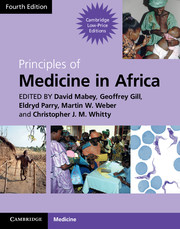Book contents
- Frontmatter
- Contents
- Contributors
- Foreword
- Section 1 Health and disease
- Section 2 Mother and child health
- Section 3 Infection: general principles
- Section 4 Major common infections
- Section 5 Bacterial infections
- Section 6 Viral Infections
- Section 7 Protozoal infections
- Section 8 Helminth infections
- Section 9 Fungal infections
- Section 10 Non-communicable diseases
- 56 Chronic and non-communicable disease in Africa
- 57 Chronic non-communicable disease in health care
- 58 Diabetes mellitus
- 59 Hypertension
- 60 Stroke
- 61 Epilepsy
- 62 Mental health
- 63 Asthma, chronic obstructive pulmonary disease (COPD) and exposure to indoor air pollution
- 64 The disabled patient
- Section 11 Diseases of body systems
- Section 12 Cancer and Palliative Care
- Section 13 Venoms and Poisons
- Index
- References
58 - Diabetes mellitus
from Section 10 - Non-communicable diseases
Published online by Cambridge University Press: 05 March 2013
- Frontmatter
- Contents
- Contributors
- Foreword
- Section 1 Health and disease
- Section 2 Mother and child health
- Section 3 Infection: general principles
- Section 4 Major common infections
- Section 5 Bacterial infections
- Section 6 Viral Infections
- Section 7 Protozoal infections
- Section 8 Helminth infections
- Section 9 Fungal infections
- Section 10 Non-communicable diseases
- 56 Chronic and non-communicable disease in Africa
- 57 Chronic non-communicable disease in health care
- 58 Diabetes mellitus
- 59 Hypertension
- 60 Stroke
- 61 Epilepsy
- 62 Mental health
- 63 Asthma, chronic obstructive pulmonary disease (COPD) and exposure to indoor air pollution
- 64 The disabled patient
- Section 11 Diseases of body systems
- Section 12 Cancer and Palliative Care
- Section 13 Venoms and Poisons
- Index
- References
- Type
- Chapter
- Information
- Principles of Medicine in Africa , pp. 498 - 509Publisher: Cambridge University PressPrint publication year: 2013

